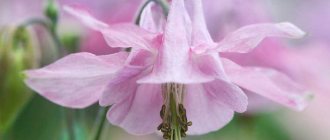Introduction and buying tips
In order for your lilies to grow well and bloom luxuriously, you need to know exactly which section they belong to. It’s even better to buy bulbs only after you have become familiar with the planting rules and outdoor growing conditions.
This way you will immediately assess your capabilities and understand whether you can provide them with proper care or whether you will be looking for a more suitable option. The fact is that agricultural technology (planting, care, wintering) and growing conditions (lighting, soil) of different types of plants are seriously different from each other.
An international classification of hybrid lilies has now been developed. It presents about 10 thousand plant varieties, divided into 10 main sections depending on their origin.
- Asian hybrids. The most popular species in gardening is the Tiger Lily.
- Hybrids Curly (Martagon).
- Hybrids Snow White. The most popular species in gardening is the white lily.
- American hybrids
- Hybrids Long-flowered
- Hybrids Tubular and Orleans
- Hybrids Oriental (Oriental)
- Hybrids between sections 1, 5, 6 and 7 of the classification, mainly Longiflorum Asiaticum (LA) and Oriental Tubular (OT).
- All wild species of lilies and their varieties.
- A variety of hybrids that are not included in any section.
In the CIS, the most common in floriculture are Asian hybrids, in particular tiger lily, Curly hybrids (Martagon), Tubular and Orleans, Longiflorum Asiaticum (LA) and Oriental Tubular (OT, also known as tree or bush) hybrids.
The magazine “Festival of Flowers” reminds that the so-called “pyramidal”, “spherical”, “curly” lilies today exist only in the imagination of unscrupulous sellers.
Buying Tips
- Do not buy lilies if it is impossible to determine exactly which group they belong to.
- We do not recommend buying late varieties of Eastern Hybrids, as they often do not have time to stock up on nutrients before wintering and die in the spring. The later they bloom and the colder the climate, the higher the likelihood of an unfavorable outcome.
- Buy bulbs from sellers with a proven, long-standing reputation. Try to avoid random people in the market and on the Internet, especially if you are interested in an expensive or rare variety.
- After preliminary familiarization with the sections of lilies, proceed to studying the varieties from the selected sections. Before going to the exhibition and sale, write down the varieties you like on a sheet of paper. If you are offered “new unique varieties with amazing characteristics at half the price” whose names you have not heard, then it is better to postpone the purchase.
- It is better not to purchase bulbs after forcing, as they often fall apart into 2-4 parts. Only after 2-3 seasons will such small bulbs gain strength and bloom.
- We advise you to buy at least three lilies of the same variety, preferably 3-7, so that you can plant them at least in a triangle or circle and get a blooming “bouquet”.
Quality of planting material
Buy fairly dense, large bulbs with living roots at least 3-5 cm in length and elastic scales. They should not have rotten or overdried scales and mold.
If you bought heavily dried bulbs or they dried out during storage, then wrap them in a damp cloth or soak them in water before planting.
When to plant lilies in open ground?
The answer to this question depends on which section the flower belongs to and the climate of your region.
| Chapter | Optimal planting dates |
| Asian (Brindle) | In the spring after the soil has thawed. For example, in the Moscow region it is early to mid-April. Autumn – September-October |
| Curly (Martagon) | Mid to late August |
| Snow-white (White)* | August |
| Tubular | Aug. Sept. The main thing is that the bulbs have time to take root before frost |
| Eastern | April-May, August |
| LA hybrids** | September-early October. It is possible in April, however, they will be a little less in height, but they will develop and bloom just as well as with autumn planting. |
| OT hybrids** | August |
* – We recommend planting white lilies only in August, due to the peculiarities of its development cycle.
** – LA hybrids and OT hybrids belong to the same section – 8, but differ from each other.
The indicated planting dates are suitable for the entire territory of the CIS; the zone of central Russia and the Moscow region is taken as a basis. Gardeners from more southern regions (Krasnodar Territory) can plant lilies 2-3 weeks earlier in the spring, and later in the fall.
Flower growers from regions with shorter summers (Ural, Siberia), on the contrary, have to plant bulbs in open ground in the spring - later (as soon as the ground thaws), and in the fall the planting deadline is earlier by about the same 2-3 weeks. At the same time, the favorable landing period itself will be shorter: from mid-August to early - mid-September.
ZKS seedlings
Lilies are planted not only as bulbs, but also as seedlings in containers, i.e. with a closed root system (ZKS). They can be planted in the spring after the end of return frosts (May) and in the summer, even during flowering.
Before planting, you just need to trim the inflorescences for better rooting. Buying a blooming lily provides one important advantage - you immediately see the color and size of the flower and know what to expect in the future.
When is it better to plant in spring or fall?
According to most experts, the best time to plant lily bulbs is August-September. However, some varieties can be planted in spring, but you need to know the features of spring planting.
| Planting lilies | Spring | Autumn |
| Advantages | Opportunity to admire flowers during planting season | Better rooting of bulbs Stronger and healthier plant due to maximum root growth Saving effort and time. Just season the bulbs and you can plant them. |
| Flaws | Bulbs must be stored until planted in open ground Poor rooting Lower height |
In practice, it has been found that bulbous plants take root better at low positive temperatures, i.e. their root system develops as actively as possible. At high positive temperatures, on the contrary, there is dynamic growth of the above-ground part of the plant.
If you don’t know exactly which section your specimen belongs to, then the most favorable time for planting lilies with bulbs of most species and varieties in the CIS is: mid-August - mid-September.
The main thing is to do it before the onset of long autumn rains, so that the soil is not too wet and the bulbs do not rot.
How to store bulbs before planting in spring?
Ideally, lilies should be planted in the spring immediately after purchase, when the soil has already thawed to a depth of 20-30 cm and has dried slightly. However, lily bulbs go on sale at the end of winter, and the desired variety may not wait for us in April, so sometimes we have to buy them earlier.
Don't be afraid to buy your long-awaited variety in February. After purchase, unsprouted bulbs (at rest) should be stored in a dark and cool place.
Cold place
- Place the lily bulbs vertically, bottom down, so that if sprouts appear, they are straight, maybe close to each other in a cardboard box or box with holes. You can also put them in a bag with holes filled with dry high-moor peat, pine sawdust or sphagnum.
- Then place the container in the refrigerator on a shelf at a temperature of +2-4 Cº. In most cases, with this storage method, the bulbs do not form a sprout longer than 5 cm.
Some gardeners prefer to place the bulbs in the basement or cellar in clean, dry sand (as if planted in it).
If you plan to plant no later than 2-3 weeks later, you can leave the bulbs in the package. If they start to sprout, make a cut near the sprout so that it does not become deformed, and then it will be easier to get them out.
Planting in a pot
If the bulb has sprouts longer than 5 cm (you bought one already or formed during storage in the refrigerator), and it has been planted in open ground for more than 2-3 weeks, then it already needs to be planted in a pot and grown at home.
Instead of a regular pot, you can use peat pots, rolled up thick paper into a “ball”, plastic bottles or juice packaging with the top cut off, etc. The container needs to be narrow but tall, so a 2-liter plastic bottle is best. There must be drainage holes at the bottom of the container.
- Place a 1-2 cm layer of sand at the bottom of the pot. Then add a 10-12 cm layer of soil mixture (peat, turf soil and sand - 1:1:1) or universal soil for indoor plants and place the bulb.
- Cover it and the sprout with the same substrate on top, the thickness of the soil layer above the sprout is 3-4 cm, and above the bulb 8-10 cm, depending on the size of the sprout and the height of the container.
- Place the pot in a bright and cool place (+ 8-10° C) and periodically water it with a small amount of water (preferably in a tray).
- After the end of the return frosts (May), transplant the flower into open ground, preserving the clod of earth, and water it. For the first 5-7 days, be sure to darken the lily in the garden for better rooting with a curtain, fabric or special mesh.
If frost is predicted, cover the flowers overnight with a container (bucket, box) or tie the stakes with cloth (air-dry shelter).
Planting a lily bulb with a sprout at home and planting it in open ground in the spring
Planting in a greenhouse
If possible, the bulbs can be planted in a greenhouse. In this case, light frosts will not be a hindrance, and the sprouts can be covered in case of severe frost. Planting is carried out according to the same principle as in open ground.
Preparing for landing
In this chapter we will look at the place and method of planting, landscaping, soil, treating bulbs for disease prevention and protection from mice, as well as the depth and spacing of lilies when planting.
Landing location
When choosing a planting site, you need to take into account the individual characteristics of the flower. Lilies from different sections need different levels of light.
Regardless of the lighting intensity, each area should be well protected from strong winds, but at the same time sufficiently ventilated. So that flowers are not affected by diseases (gray rot, etc.) from stagnant humid air and excessive dampness.
Lilies should not be planted in flooded areas after melting snow or heavy rain and in lowlands, as stagnation of water leads to rotting of the bulbs and death.
In bright sunshine, they must be watered abundantly, but rarely, so as not to dry out. Otherwise, they will develop poorly and fade faster.
| Chapter | Landing location |
| Asian (Brindle) | Photophilous. They develop better in an open area, but can also be planted in light shade near bushes, trees, fences and buildings. The sun's rays should hit them for at least half of the daylight hours. |
| Curly (Martagon) | Sunny place, partial shade with diffused light with protection from strong winds so that the shoots are not damaged. |
| Snow-white (White) | Sunny place, light partial shade. |
| Tubular | Sunny and sheltered from the wind place. |
| Eastern | Sunny place, partial shade. |
| LA hybrids* | Just like Asian hybrids. |
| OT hybrids* | Partial shade, diffused light. |
* – LA hybrids and OT hybrids belong to the same section – 8, but differ from each other.
If you don’t know the exact species, then in general it is better to plant the lily in partial shade with sunlight in the first half of the day. At the same time, you need to protect it from morning drops of water on the leaves so that there is no sunburn and gray rot (if the weather is humid, warm and windless).
Landscape design
When planting lilies, consider their height, size, shape and color of the flower. Tall species look beautiful in the background of a flower garden or in separate groups of 3-5 specimens of the same variety, and low plants with small flowers on an alpine hill.
Golden Rule
Flowers develop well when low or medium-sized plants grow next to them, which shade the lower part of their stems. After all, in addition to beauty, this way we can protect the soil from overheating and drying out in the heat and from severe freezing in winter.
At the same time, they need sun to bloom profusely. The famous florist Tatyana Mitrofanova poetically described this rule as follows: “Legs in the shade, and head in the sun.” Lily growers recommend planting ground cover plants especially next to Oriental hybrids.
Successful neighbors: astilbe, heuchera, bellflower, daisy, daylily, primrose, sedum, creeping phlox, hosta, any annuals and others.
In partial shade you can plant next to rhododendron, fern, peony.
Attention! The Flower Festival magazine strongly recommends not to plant lilies in deep shade under trees and tall shrubs with a dense crown and severely deplete the soil.
The soil
The flower is very demanding on the soil and since it will grow in one place for several years, it is better to prepare the soil in advance in the area for planting. Lilies love well-drained, loose and fertile soil with a thick layer of humus.
Light loam, fertilized sandy loam soil and black soil suit them well. Soils with low water and air permeability (clayey) and moisture holding capacity (sandy) are unsuitable for growing flowers.
On heavy soils, the bulbs will rot due to the accumulation of moisture between the scales. Such soil is made more loose by adding coarse sand, agroperlite or crushed small crushed stone.
Soil acidity is also of great importance. Some species and varieties love slightly acidic soil and do not tolerate alkali, while others, on the contrary, need liming and do not grow well on an acidic substrate.
This feature affects the choice of material for mulching the growing site. Asian, Oriental, LA hybrids and OT hybrids can be mulched with peat and sawdust, as they increase the acidity of the soil. And Curly lilies (Matragon), white and Tubular lilies are best mulched with leaf humus.
| Chapter | Soil acidity* |
| Asian (Brindle) | Not very demanding, but slightly acidic soil is better. Ph – 5.5-7.5. |
| Curly (Martagon) | Ph – 6.5-7.5. Slightly acidic or alkaline soil, close to neutral. |
| Snow-white (White) | Ph – 7.0-8.0. They do not like acidic soil, but can tolerate slightly alkaline soil. |
| Tubular | Ph – 7.0-8.0. Alkaline soil does not develop well in acidic soil. |
| Eastern | Ph – 5.5-7.0. Slightly acidic soil. |
| LA hybrids** | Ph – 6.0-7.5. Neutral reaction. |
| OT hybrids** | Ph – 5.5-7.0. Prefer slightly acidic soil. |
* – Ph = 7 – neutral soil, below 7 – acidic, above 7 – alkaline
** – LA hybrids and OT hybrids belong to the same section (8), but differ from each other.
REFRESH YOUR KNOWLEDGE:
- HOW TO FIND OUT THE ACIDITY OF THE SOIL AND CHANGE?
Treatment of bulbs before planting and protection from mice
Before planting, we recommend treating the bulbs to prevent rot and fungal diseases. If mice are frequent guests in your area, be sure to take measures to protect the bulbs from them.
Disease Prevention
- 20 minutes in a 0.2% solution of foundationol, karbofos (a teaspoon per 3 liters of water) or the drug “Maxim”.
- 30 minutes in a solution of potassium permanganate (1 g per 2 liters of water, teaspoon per 10 liters of water)
After pickling the bulbs, dry them in the shade for 2-3 minutes. You cannot dry it in the sun, as the roots tend to dry out.
If these drugs are not available, then as a preventive measure against diseases of lilies, we recommend dusting the bulbs well with crushed wood ash (ash).
Protecting lily bulbs from mice
Rodents often eat many bulbous (hyacinths, tulips), corms and rhizomatous plant species that do not contain toxic substances. Mice pose a particular threat to lilies in the winter, when they have little food choice, but they are also dangerous in the spring and summer.
Therefore, in order not to be upset, be sure to take care of protecting the bulbs when planting in spring, summer and autumn, without exception. Experienced flower growers share their experience and offer these methods of fighting mice.
- Plant the bulbs in mesh plastic bags (for storing vegetables or fruit packaging in the supermarket), metal mesh, cut plastic bottles or special baskets. Then mouse-like rodents will not be able to reach them. Particularly valuable varieties can be planted in steel wool (metal sponge) for washing dishes.
- Lubricate lily bulbs with Vishnevsky ointment or birch tar.
- After a snowfall, be sure to trample the paths around the flower planting site so that mice cannot walk under the snow.
- Around the beds with lilies, it is recommended to plant autumn crocus, narcissus, lily of the valley, field mint, hazel grouse, and true snowdrop.
Vishnevsky ointment
Preface from an expert: “It was important for me to find a product with a 100% guarantee of protecting lily bulbs from mice, since the collection contains very rare and expensive varieties. This method has proven its reliability over many years. At the same time, it is simple and cheap.”
- Dilute Vishnevsky ointment a little with warm water to the consistency of sour cream.
- Coat the bulbs completely with the resulting solution and then plant them.
Mice do not touch lilies, as the ointment has a pungent odor. The second advantage of the method is that Vishnevsky ointment serves as a prophylactic against many diseases.
Baskets for bulbs
We will also dwell in more detail on the use of baskets for bulbous and tuberous plants specifically for planting lilies. Baskets of various shapes and sizes are available on sale. Of those options that are commercially available, we advise you to choose the deepest ones possible, but most of them are 8-10 cm.
In general, in our opinion, baskets are not exactly suitable for lilies, but they are more suitable for tulips and hyacinths.
- Low height. If you plant large bulbs at the required depth (12-15 cm), the box will go completely underground, and it will be inconvenient to dig it out of the ground.
- Convenience. It is not always possible to place bulbs in a basket at the required distance from each other, and planting 1-2 bulbs in one basket is not rational.
- Cost and storage. On the one hand, they are not very expensive (30-50 rubles), but if one basket for one variety contains 1-3 onions, and you need 15-20 of them, then they are not so cheap. At the same time, you also need to store them somewhere in winter.
- Mice protection. One of the main reasons for using a basket, but it raises questions. Since the lilies are not protected from above the planting site and inside the basket, mice can easily climb on top.
Advice from the magazine "Festival of Flowers". If you want to get your own experience using a basket for bulbs, you can save money and take a regular plastic box. It is also better to plant young bulbs, as they need a shallower planting depth and are varieties that you are willing to risk in case of failure.
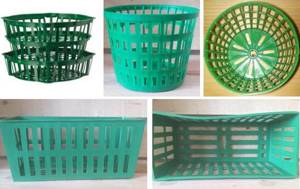
Popular options for baskets for planting bulbous plants
Planting depth and distance between bulbs
Another important point in the process of planting lilies. The planting depth primarily depends on the rooting characteristics of a particular species, as well as on the height of plants of different varieties, soil composition and bulb size.
Soil composition. In light sandy soil, bulbs of the same variety should be planted a little deeper (2-4 cm).
Bulb size. Large bulbs are planted deeper than small ones by 3-5 cm.
Standard depth and tables
If you don’t know exactly the type of lily, then the universal planting depth will be three bulb diameters from its top. For example, the diameter is 5 cm, then the planting depth is 15 cm. The only exceptions to this rule are a few types of plants, for example, white Lily, Catsby and terracotta (2-3 cm).
General table for most types of planting depth and distance between lilies depending on the height of the flower and the size of the bulb.
| Grade height | Small bulbs | Large bulbs | Landing distance |
| short | 7-8 cm | 10-12 cm | 15-20 cm |
| Average | 8-10 cm | 12-15 cm | 20-25 cm |
| High | 10-12 cm | 15-20 cm | 25-30 cm |
Table of planting depth, planting hole and distance between bulbs when planting lilies according to sections.
| Chapter | Planting depth (from the top of the bulb) | Planting pit | Landing distance |
| Asian (Brindle) | 8-12 cm depending on the size of the bulb. | 20-25 cm. | At least 30-35 cm. |
| Curly (Martagon) | 10-15 cm or 20-25 cm from the bottom. | Twice as deep. | 25-30 cm |
| Snow-white (White) | 2-3 cm. Do not bury it! | 20-25 cm. | Between bulbs - 15 cm, other plants - 20-25 cm. |
| Tubular | 3-3.5 bulb heights. On light soil it is deeper than on heavy soil. | Twice as deep. | 30-35 cm |
| Eastern | About 15 cm. In the northern regions 15-20 cm. | Twice as deep. | At least 20-25 cm. Depends on the height of the variety. |
| LA hybrids* | 10-15 cm | Twice as deep. | 30-35 cm |
| OT hybrids* | 10-15 cm | Twice as deep. | 30-40 cm |
* – LA hybrids and OT hybrids belong to the same section (8), but differ from each other.
Why is it better to plant a little deeper?
- If you plant lily bulbs deeper than recommended by 3-5 cm (depending on the size, soil and height of the variety, usually 15-20 cm from the top), then they will sprout a little later in the spring and will not be subject to frost. This is especially good for gardeners from regions where frosts can return in late spring and even in late May - early June (Urals, Siberia). In this case, low shoots (10-15 cm) are much easier to cover than already overgrown bushes.
- At greater depths, the soil is wetter and the flowers tolerate heat better. This is more relevant for gardeners from regions with hot and dry summers.
- Bulb roots take longer to grow in fall and winter because the soil freezes later.
- The underground part of the flowering shoot is longer and a larger number of stem roots and baby bulbs are formed on it.
Rules for proper care of lilies
If someone tells you that lilies are unpretentious and require minimal care, do not believe them. In order for these inimitable and delightful flowers to decorate your garden plot, it is necessary to create suitable conditions for the plants in which they will feel comfortable.
After planting, lilies need care so that the bulbs take root and begin to grow. For best results, it is necessary to carry out the following work in a timely manner:
- moderate watering;
- loosening and weeding;
- feeding;
- pruning after flowering.
Let's consider all the stages of caring for garden lilies after planting in more detail.
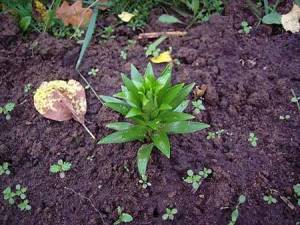
Secrets of proper watering
The first and main stage of caring for a lily after planting is moderate and timely watering. It is necessary to water the flowers as the soil dries out. Under no circumstances should you overwater the plants, otherwise the bulbs will begin to rot and may die. Overmoistening can also cause the occurrence and spread of fungal diseases.
It is necessary to water lilies at the root; it is not advisable to irrigate sprouts and shoots. Watering can be combined with the application of fertilizers in liquid or dry form.
If the summer turns out to be dry, lilies need to be watered more often and more abundantly, as the plants weaken with a lack of moisture. Also, moisture deficiency affects the appearance of the plant, and the abundance of flowering decreases. The flowers become small, faded and inconspicuous.

Advice! Experienced gardeners advise removing all buds from lilies in the first year after planting, since flowering takes a lot of energy from the plant. Weakened flowers may not survive severe winter frosts.
After flowering, the plants no longer need abundant moisture, so the rate and regularity of watering is halved.
Weeding and loosening flower beds
Loosening the soil and regular weeding is the key to active growth and abundant flowering of lilies. You need to loosen the soil after each watering or precipitation.
Try not to loosen the soil too deeply, so as not to damage the bulbs and not touch the children that form over time. It is advisable to abandon loosening 1.5-2 months after planting so as not to damage the stem bulbs.
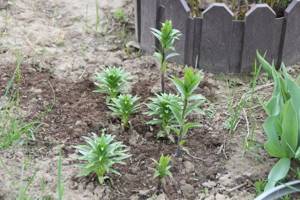
Try to keep an eye on the flower garden so that the lilies are not overgrown with weeds. Weed your flowers as often as possible. If you wish, you can mulch your flower beds to make your work easier and protect your plants.
Timely application of fertilizers
Feeding lilies in the spring is an important stage in caring for lilies in the country or in the garden. Fertilizers must be applied in accordance with the recommendations of experienced gardeners.
A lack of nutrients will invariably affect flowering. After all, plants belonging to the lily group grow in one place without transplanting for up to 4-5 years. Therefore, your task is to feed the flowers competently and regularly, restoring the balance of minerals and nutrients. You can learn more about how, when and what to feed lilies from the article.
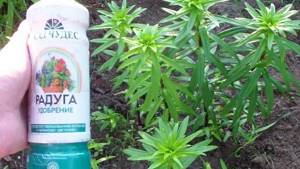
Important! Not all bulbous flowers can be planted next to lilies. Tulips and gladioli are undesirable neighbors, but imperial hazel grouse or daffodils will scare away mice that like to eat the bulbs.
Caring for lilies after flowering
Luxuriously blooming lilies are an unforgettable and delightful sight. Unfortunately, this beauty is short-lived. The buds gradually lose their petals, fade, and in place of graceful and magnificent flowers there remains an inconspicuous stem with gradually fading leaves.
Many flower growers make the mistake of pruning lilies immediately after flowering, wanting to give the flower beds a well-groomed appearance, and later lament that the bulbs become weak, are affected by fungal diseases, and often freeze out. In this case, the rules for pruning lilies after flowering were grossly violated.

Do I need to prune lilies after flowering and how to do it correctly? Immediately after the petals fall off, the inflorescences must be removed. There is no need to cut off the stems immediately. The plant receives nutrients through the foliage, and until the leaves begin to turn yellow, the stems cannot be cut. As the foliage turns yellow, the flower stalks are gradually shortened.
Pruning lilies after flowering is an essential step in flower care. While the leaves are green, they nourish the bulb, strengthening it and delivering the necessary elements to it. When pruning, the cuts are made oblique so that rainwater does not accumulate, but flows down the stem. Straight cuts can lead to rotting of flower stalks. At a height of 15-20 cm, the stems are left until autumn.
Plants are not pruned only when it is necessary to collect seeds from individual specimens. In this case, the inflorescences are left alone until the seed pods ripen.
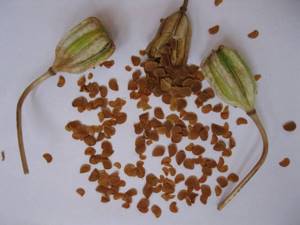
Important! You can cut stems or flowers for cutting only with a clean and sharp tool.
How to plant correctly? Instructions
- Before planting, dig the soil 25-30 cm deep. Add a bucket of sand and peat per 1 m² to heavy soil, and only peat to light soil. Or prepare a soil mixture for lilies: turf soil, peat and humus - 1:1:1. For flowers that prefer slightly acidic soil (Asian (tiger), Oriental, LA hybrids, OT hybrids), you can make the following substrate: turf soil, peat, sand and pine litter - 1:1:1:1.
- Depending on the fertility of the soil, add 1-2 buckets of compost or humus per 1 m². This is enough for lilies growing in slightly acidic soil. And for Tubular hybrids, snow-white lilies and Martagon, you need to add 200-500 g per 1 m² of wood ash or dolomite flour to reduce the acidity of the soil.
- Mix all the ingredients well with garden soil and dig a planting hole or furrow of the required depth. Usually twice as deep as the recommended planting depth for bulbs (+10-15 cm to it) or in most cases - 20-30 cm.
- Test the bulb in the hole at the recommended depth. Place a layer of soil mixture and then sand at the bottom of the hole. You can pour a mound of sand and place an onion with straightened roots in it, or simply pour a 2-3 cm layer.

Planting pit with sand mound - Place the bulbs at the required distance, straighten their roots and fill the voids on the sides with soil substrate. Water the planting grooves (holes) with a small amount of water.
- Fill the planting hole or furrow completely with the soil mixture and water it generously for better rooting. After the soil subsides, sprinkle it on top and water it again.
- Asian, Oriental and LA Hybrids must be mulched with a 3-5 cm layer of peat or pine sawdust, litter or small shavings (increase the acidity of the soil). As mulch for Tubular hybrids, white lily and Martagon, use leaf humus with wood ash (3:1).
- When planting in the fall, it is recommended to place a film on top of the mulch, and spruce branches and leaves under it. Such shelter for the winter must be done before the first autumn rains and is mandatory for Eastern hybrids, since in their natural habitat it is dry in autumn and winter. Asian hybrids, LA hybrids and OT hybrids do not need to be covered with film.
- In spring, remove the film, spruce branches and leaves from the planting site as early as possible, immediately after the final melting of the snow (Moscow region: late March - early April), so as not to damage the sprouts. There is no need to rake the mulch; it is useful for retaining moisture.
Covering with film for the winter
Only dry soil can be covered with film. If it rains already in September, then lay the film and place leaves and spruce branches under it only after the top layer of the earth has frozen (also one of the ways to protect the bulbs from mice).
In a sheltered planting site, the ground does not freeze much longer, and the roots of the plant continue to develop until severe frosts occur. Since their root system is capable of growing even at slightly above-zero temperatures.
How to plant an onion with a sprout?
It is better to plant an onion with a too large and curved sprout (longer than 5 cm) at an angle, i.e. carefully place it on its side so that it looks up and does not break off. If the sprout is straight, then plant it as usual, just cover it carefully with soil.
Sprouted lily bulbs are most often sold in the spring, but sometimes in the fall (those that were not sold in the spring), usually brought from Europe.
When planting in the fall, the sprout on the bulb must be carefully unscrewed, since it does not need to grow in winter, and next spring a new one will form in its place.

Lily bulb with sprout
Planting in a container
Lilies can be grown not only in a flowerbed, but also in a container (large pot, pan, flowerpot, bucket, etc.). It is better to plant varieties up to 60-70 cm in height. This method of growing has its advantages.
- For the winter, you don’t have to dig up the bulbs, but simply put the container in a cool place with a temperature of 2-4 °C (freeze-free basement or cellar). And winter-hardy varieties can be placed in a trench and covered with leaves or sawdust for the winter, and then covered with snow.
- It’s easier to find a good place for growing - the container can be moved to the sun in the spring or in hot weather (July, August) placed in partial shade. It can also be placed in places unsuitable for planting: on asphalt and paths, patios and gazebos, verandas.
- If the soil on the site is not suitable for flowers, and preparing it is too difficult, then you can make the necessary soil mixture in a small volume specifically for a particular species.
- In order for lilies to bloom earlier in spring or winter, containers can be brought into a warm room in the fall after the end of the growing season (before the first frost). Provided there is sufficient lighting, Asian hybrids bloom in 60-70 days, Tubular - 100-130, and Oriental - 120-140.
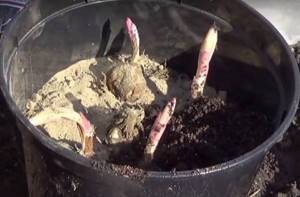
Planting lilies in a container (bucket) instead of a flower bed
Adviсe
- At the bottom of the hole, sand drainage is mandatory for Eastern hybrids, and recommended for representatives of other sections. If the soil is heavy, then sand can be poured around the bulb, as well as a 1-2 cm layer on top, so that the scales do not rot.
- If the soil is too dry, then 1-2 days before planting it is advisable to water it to the required depth so that it is slightly moist.
- After preparing the soil mixture, you can spill it with a strong solution of potassium permanganate to prevent diseases and rot, and only then apply and mix fertilizers. This treatment is especially recommended when planting Oriental hybrids.
- It is useful to add pine litter to the root zone (5-10 cm layer) or to the soil mixture. In order for a sufficient amount of nitrogen to remain in the soil (it absorbs it), nitrogen fertilizer (urea) must be added. Over 3-5 years, the litter in the ground rots, earthworms turn it into humus and neutralize acidity. In addition to litter, you can use pine sawdust; if there are a lot of earthworms in the soil, then there will be no negative effect from them. It is better to use needles for Asian, Oriental, LA hybrids and OT hybrids. This recommendation is from Stefan Fedorovich Nedyalkov from Belarus, a gardener with 30 years of experience.
- It is not recommended to add manure to the soil mixture, as it often causes the development of various fungal diseases in flowers.
- It is good to plant lilies in three-year-old compost soil, and then mulch it on top. Advice from Peter Samsonovich Kiselev from Istra, Moscow region.
- If the land is sufficiently fertile, then you don’t need to add mineral fertilizers in addition to compost, and if not, then you can add 50 g of potassium sulfate and 100 g of superphosphate per 1 m².
- If you are planting tall varieties (120-150 cm) and assume that the flower will need support during heavy flowering, especially in strong winds or rain, then it is better to install it immediately. If you place a stake next to an adult plant, you can snag and damage the bulb.
- Instead of a stake for support, in any case, place a mark (stick, peg) where the bulb is planted in the fall to know its exact location in the spring.
We wish you a successful and easy landing!
ADDITIONS TO THE ARTICLE:
- WHEN AND HOW TO CORRECTLY TRANSPLANT LILIES?
- POPULAR FLOWERS SIMILAR TO LILY FROM PHOTO!
Where to plant
Everything is simple here. Plants love the sun and do not tolerate dark places. Therefore, choose open flower beds. It is important that they are well ventilated, but protected from drafts and the vagaries of bad weather - tall stems are easily broken by strong winds. Places flooded with rain and lowlands in which melt water accumulates are also not suitable for them. It is advisable to place the flower bed intended for planting higher and protect it with sides from erosion.
Related article:
So that the lilies bloom magnificently

Transplanting lilies
Be sure to take into account previous plantings. If gladioli or tulips grew on the site, it would be a bad choice, because the plants have the same diseases as lilies. The ideal solution is to plant them after marigolds. These flowers heal the soil and contribute to the death of pests.
As for the soil, the variety must be taken into account, because the difference in the choice of soil is colossal. White hybrids require alkaline, tubular hybrids require neutral, Martagon and Oriental hybrids require sour. A mistake will cost beautiful flowering and proper development of plants.


